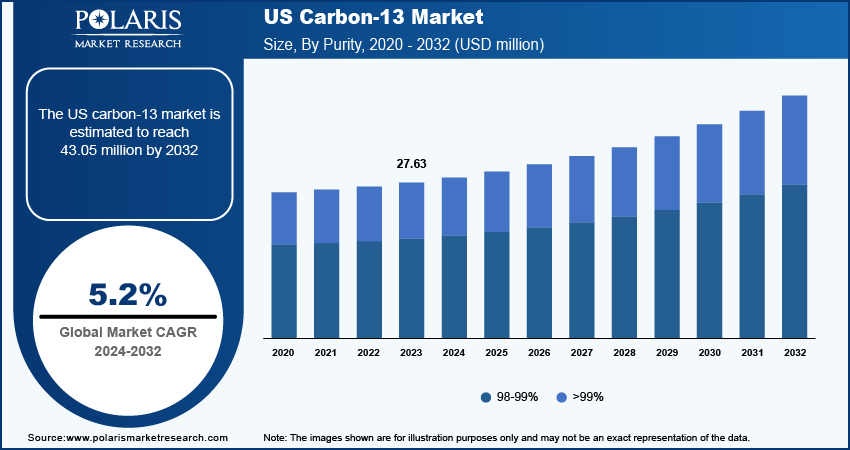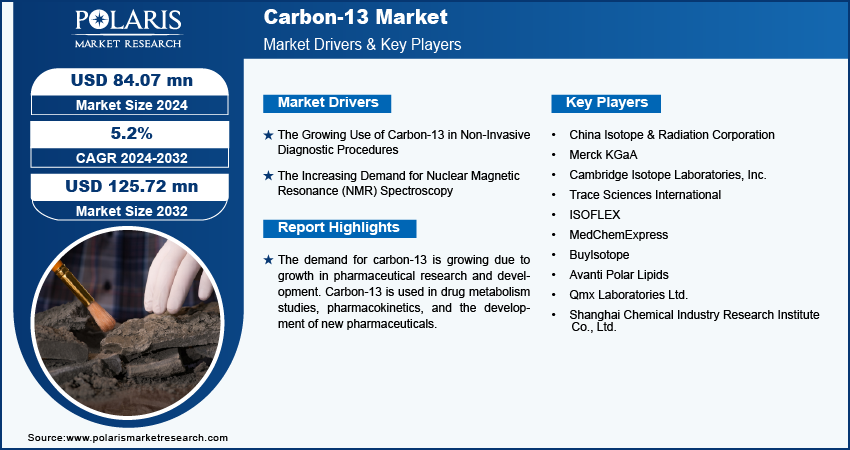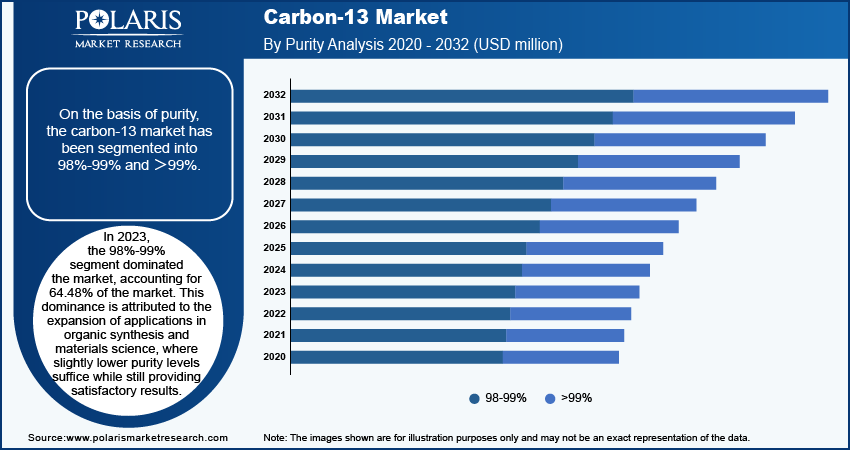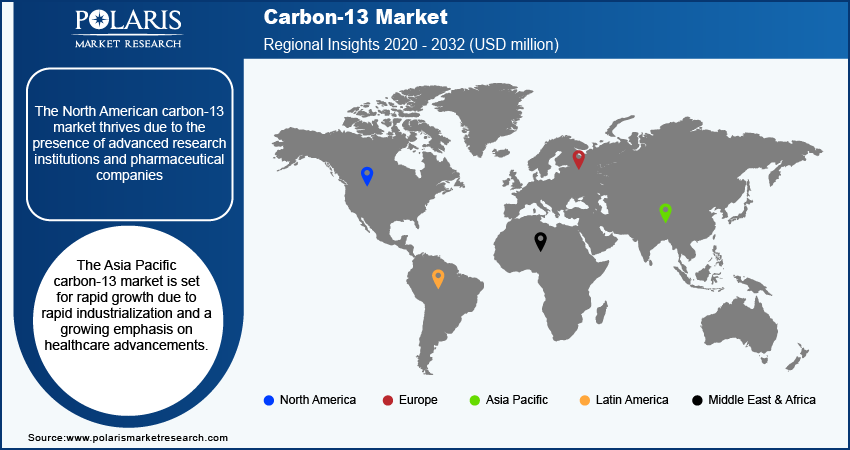
Carbon-13 Market Size, Share, Trends, Industry Analysis Report: By Purity (98%-99% and >99%), Application, End User, and Region (North America, Europe, Asia Pacific, Middle East & Africa, and Latin America) – Market Forecast, 2024 - 2032
- Published Date:Oct-2024
- Pages: 116
- Format: PDF
- Report ID: PM5100
- Base Year: 2023
- Historical Data: 2019-2022
Carbon-13 Market Overview
Carbon-13 market size was valued at USD 81.57 million in 2023. The market is projected to grow from USD 84.07 million in 2024 to USD 125.72 million by 2032, exhibiting a CAGR of 5.2% during the forecast period.
The carbon-13 (C-13) market represents a specialized but crucial segment within the broader isotopic and scientific research markets. Carbon-13 is a stable isotope of carbon, which naturally occurs in about 1.1% of all carbon atoms.
Carbon-13 has become indispensable in a range of high-precision applications across multiple industries, including healthcare, environmental science, and chemical research, due to its unique nuclear properties, such as its ability to be easily detected and analyzed through various spectroscopic methods.
The growth in pharmaceutical research and development is projected to propel the global Carbon-13 market. Carbon-13 is used in drug metabolism studies, pharmacokinetics, and the development of new pharmaceuticals. As pharmaceutical companies invest in R&D to discover and develop novel therapies, including personalized medicine, the demand for carbon-13 in metabolic studies and drug testing is expected to rise.

To Understand More About this Research: Request a Free Sample Report
The carbon-13 market is driven by the increasing emphasis on personalized medicine and the development of more advanced diagnostic tools. Personalized medicine, which tailors medical treatment to the individual characteristics of each patient, often requires highly specific diagnostic tests, including those that use isotopic labeling to track metabolic pathways or drug distribution within the body. As healthcare continues to advance towards more personalized approaches, the demand for carbon-13 in diagnostic and therapeutic applications is expected to grow.
Carbon-13 Market Drivers Analysis
Growing Use of Carbon-13 in Non-Invasive Diagnostic Procedures
The growing use of Carbon-13 in non-invasive diagnostic procedures, particularly breath tests, is a significant driver of the carbon-13 market, reflecting the broader trends in healthcare towards more patient-friendly, accurate, and cost-effective diagnostic methods. Carbon-13, a stable isotope of carbon, has unique properties that make it particularly suitable for use in breath tests, which have become increasingly popular for diagnosing various gastrointestinal and metabolic disorders.
The carbon-13 urea breath test (UBT) is widely regarded as the gold standard for non-invasive diagnosis of H. pylori. In this test, a patient ingests urea labeled with carbon-13. If H. pylori is present in the stomach, the bacterium's urease enzyme breaks down the urea, releasing Carbon-13-labeled carbon dioxide, which is then measured in the patient's breath. The accuracy, simplicity, and non-invasiveness of this test have made it a preferred choice for both patients and healthcare providers, significantly driving demand for carbon-13.
Beyond H. pylori diagnosis, carbon-13 breath tests are being developed and used for diagnosing a variety of other gastrointestinal and metabolic disorders. For instance, breath tests using carbon-13-labeled substrates are employed to assess liver function by measuring the metabolism of specific compounds. In these tests, patients ingest a Carbon-13-labeled compound that is metabolized by the liver, and the resulting Carbon-13-labeled carbon dioxide is measured in the breath.
Increasing Demand for Nuclear Magnetic Resonance (NMR) Spectroscopy
The increasing demand for nuclear magnetic resonance (NMR) spectroscopy is significantly driving the expansion of the carbon-13 market. NMR spectroscopy is a powerful analytical technique used to determine the structure, dynamics, reaction state, and chemical environment of molecules. It relies on the magnetic properties of atomic nuclei, and carbon-13, with its favorable nuclear spin properties, is one of the most widely used isotopes in NMR.
Carbon-13 NMR, in particular, is used extensively to label specific atoms within a drug molecule, allowing researchers to track its behavior and interactions at a molecular level. This capability is vital for rational drug design, where understanding the exact configuration of a drug molecule and its binding site on a target protein can lead to the development of more effective and targeted therapies. As pharmaceutical companies continue to invest in the discovery of new drugs, the demand for carbon-13, as a critical component of NMR spectroscopy, continues to rise.
NMR spectroscopy, including carbon-13 NMR, is also instrumental in the analysis of complex biological systems and metabolic pathways, which are key areas of interest in pharmaceutical research. For instance, metabolic profiling or metabolomics, which involves the comprehensive analysis of metabolites in a biological sample, relies heavily on NMR spectroscopy. Carbon-13-labeled compounds are often used as tracers to study metabolic fluxes and pathways, providing insights into disease mechanisms and potential therapeutic targets.

Carbon-13 Market Segment Insights
Carbon-13 Market Breakdown by Purity Insights
On the basis of purity, the carbon-13 market has been segmented into 98%-99% and >99%. In 2023, the 98%-99% segment dominated the market, accounting for 64.48% of the market. This dominance is attributed to the expansion of applications in organic synthesis and materials science, where slightly lower purity levels suffice while still providing satisfactory results. The cost-effectiveness of this purity range makes it an attractive option for manufacturers seeking to optimize production costs without compromising performance. Additionally, industries such as agrochemicals and environmental monitoring are increasingly utilizing isotopes for tracing and analysis, further propelling the demand for this segment. As companies aim to balance quality with affordability, the 98%-99% purity range is poised to become a pivotal segment in the market, addressing both economic and operational needs.
Carbon-13 Market Breakdown by Application Insights
On the basis of application, the carbon-13 market has been segmented into nuclear magnetic resonance (NMR) spectroscopy, magnetic resonance imaging (MRI), carbon dating, breath test, and others. The nuclear magnetic resonance (NMR) spectroscopy segment accounted for the largest share in 2023 and is expected to register at a 5.5% CAGR over the forecast period. The growth in this segment can be attributed to the widespread use of NMR in both academic research and industrial applications, particularly in fields such as drug discovery, organic chemistry, and materials science. Researchers highly value NMR for its ability to provide detailed structural information about molecular compounds. As pharmaceutical companies increasingly invest in research and development to discover new drugs and optimize existing formulations, the demand for NMR spectroscopy continues to grow. Additionally, the rising trend of utilizing advanced analytical techniques to ensure compliance with regulatory standards further solidifies NMR's dominant position in the market.
The magnetic resonance imaging (MRI) segment is projected to reach USD 16.80 million by 2032 from USD 11.18 million in 2023, growing at an estimated CAGR of 4.9% during the forecast period. The growth is attributed to the expansion of healthcare infrastructure and technological advancements in imaging capabilities. As healthcare providers increasingly prioritize non-invasive diagnostic methods, MRI stands out for its ability to deliver high-quality images of soft tissues, which is critical for accurate diagnoses. The rising prevalence of chronic diseases, alongside an aging population, significantly boosts the demand for effective imaging solutions in clinical settings. Innovations in MRI technology, such as enhanced resolution and faster scanning times, also play a crucial role in attracting investment and encouraging widespread adoption.

Carbon-13 Market Breakdown by Regional Insights
By region, the study provides market insights into North America, Europe, Asia Pacific, the Middle East & Africa, and Latin America. North American carbon-13 market accounted for 30.12 million in 2023 and is estimated to grow at a CAGR of 5.2% during the forecast period. This growth stems from the presence of advanced research institutions and pharmaceutical companies. The US, in particular, dominated this region due to its significant investments in research and development across various sectors, including healthcare, chemical manufacturing, and materials science. The country’s well-established regulatory framework encourages innovation and the adoption of high-precision analytical techniques. Furthermore, the increasing emphasis on personalized medicine and advanced diagnostics has bolstered demand for isotopes in clinical applications, further enhancing market growth in North America.

Carbon-13 market in Europe is projected to reach $ 37.48 million by 2032 from $ 24.68 million in 2023. The rapid growth of Europe is due to strong research initiatives and a robust pharmaceutical sector. Countries such as Germany and the UK emerged as key contributors, owing to their advanced research institutions and well-established healthcare systems. The region’s commitment to innovation in drug development and diagnostic technologies has fostered a favorable environment for the use of high-purity isotopes in both academic and commercial settings. Moreover, European regulatory agencies actively support the integration of advanced analytical techniques, which further boosts demand for isotopes in applications such as nuclear magnetic resonance (NMR) spectroscopy and magnetic resonance imaging (MRI).
Asia Pacific carbon-13 market is expected to grow at a significant CAGR from 2024 to 2032. In Asia Pacific, the carbon-13 market is driven by rapid industrialization and a growing emphasis on healthcare advancements. Countries such as China and India are emerging as key countries in the market due to their expanding pharmaceutical and biotechnology sectors. The increasing prevalence of chronic diseases in these nations necessitates improved diagnostic and therapeutic technologies, propelling demand for isotopes in medical applications like imaging and research. Additionally, significant government initiatives aimed at enhancing healthcare infrastructure and research capabilities will likely foster an environment conducive to growth.
Carbon-13 Key Market Players & Competitive Insights
Major market players are investing heavily in research and development in order to expand their product lines, which will help the carbon-13 market grow even more. Market participants are also undertaking a variety of strategic activities to expand their global footprint, with important market developments including new product launches, contractual agreements, mergers and acquisitions, higher investments, and collaboration with other organizations. To expand and survive in a more competitive and rising market climate, the carbon-13 market must offer cost-effective items.
Major players in the carbon-13 market include China Isotope & Radiation Corporation; Merck KGaA; Shanghai Chemical Industry Research Institute Co., Ltd.; Cambridge Isotope Laboratories, Inc.; Trace Sciences International; ISOFLEX; MedChemExpress; BuyIsotope; Avanti Polar Lipids; and Qmx Laboratories Ltd.
China Isotope & Radiation Corporation is a subsidiary of China National Nuclear Corporation (CNNC) and the largest nuclear enterprise in China, focusing on research, development, manufacturing, distribution, and service of nuclear products. CIRC specializes in radioisotope and radiation technology, offering a wide range of products, including radiopharmaceuticals, radioactive sources, and radiation processing services. The company has over 50 production lines serving both domestic and international markets through its 70 nuclides and 300 different kinds of products.
MedChemExpress is a chemical manufacturing company that specializes in kinase inhibitors, enzyme inhibitors, tyrosine kinase inhibitors, protein kinase inhibitors, protein inhibitors, phosphatase inhibitors, cancer drug candidates, cancer inhibitors, cell signaling inhibitors, ADC, Immune, and PROTAC. MedChemExpress offers a wide range of life-science reagents, reference compounds, and natural products. The company prioritizes product quality through stringent quality control measures, including HNMR, LC-MS, HPLC, stability testing, and activity assays. MCE's product portfolio includes biologically active compounds, signaling pathways, screening libraries, and a wide array of research areas such as cancer, cardiovascular disease, and neurological disease. The company is customer-oriented, offering flexible order volumes and timely delivery.
List of Key Companies in Carbon-13 Market
- China Isotope & Radiation Corporation
- Merck KGaA
- Shanghai Chemical Industry Research Institute Co., Ltd.
- Cambridge Isotope Laboratories, Inc.
- Trace Sciences International
- ISOFLEX
- MedChemExpress
- BuyIsotope
- Avanti Polar Lipids
- Qmx Laboratories Ltd.
Carbon-13 Industry Developments
January 2022: Merck, a major science and technology company, announced the expansion of its stable isotope center of excellence in Miamisburg, Ohio. The new infrastructure increases the production capacity of the GMP-grade urea-13C Active Pharmaceutical Ingredient (API) used by Urea-13C Breath Test (UBT) kit manufacturers by more than 50%.
Carbon-13 Market Segmentation
By Purity Outlook (Revenue, USD million, 2020 - 2032)
- 98%-99%
- 99%.
By Application Outlook (Revenue, USD million, 2020 - 2032)
- Nuclear Magnetic Resonance (NMR) Spectroscopy
- Magnetic Resonance Imaging (MRI)
- Carbon Dating
- Breath Test
- Other
By End User Outlook (Revenue, USD million, 2020 - 2032)
- Healthcare
- Chemicals
- Academia and Research Institutions
- Environmental Agencies
By Regional Outlook (Revenue, USD million, 2020 - 2032)
- North America
- US
- Canada
- Europe
- Germany
- France
- UK
- Italy
- Spain
- Netherlands
- Russia
- Rest of Europe
- Asia Pacific
- China
- Japan
- India
- Malaysia
- South Korea
- Indonesia
- Australia
- Vietnam
- Rest of Asia Pacific
- Middle East & Africa
- Saudi Arabia
- UAE
- Israel
- South Africa
- Rest of Middle East & Africa
- Latin America
- Mexico
- Brazil
- Argentina
- Rest of Latin America
Carbon-13 Report Scope
|
Report Attributes |
Details |
|
Market Size Value in 2023 |
USD 81.57 million |
|
Market Size Value in 2024 |
USD 84.07 million |
|
Revenue Forecast in 2032 |
USD 125.72 million |
|
CAGR |
5.2 % from 2024 to 2032 |
|
Base Year |
2023 |
|
Historical Data |
2020 – 2022 |
|
Forecast Period |
2024 – 2032 |
|
Quantitative Units |
Revenue in USD million and CAGR from 2024 to 2032 |
|
Report Coverage |
Revenue Forecast, Market Competitive Landscape, Growth Factors, and Industry Trends |
|
Segments Covered |
|
|
Regional scope |
|
|
Competitive Landscape |
|
|
Report Format |
|
|
Customization |
Report customization as per your requirements with respect to countries, regions, and segmentation. |
FAQ's
The global carbon-13 market size was valued at USD 81.57 million in 2023 and is projected to grow to USD 125.72 million in 2032.
The global market registers a CAGR of 5.2% during the forecast period, 2023-2032
North America held the largest share of the global market in 2023.
The key players in the market are China Isotope & Radiation Corporation; Merck KGaA; Shanghai Chemical Industry Research Institute Co., Ltd.; Cambridge Isotope Laboratories, Inc.; Trace Sciences International; ISOFLEX; MedChemExpress; BuyIsotope; Avanti Polar Lipids; and Qmx Laboratories Ltd.
The 98%-99% segment dominated the market in 2023.
The nuclear magnetic resonance (NMR) spectroscopy segment had the largest share in the global market.
